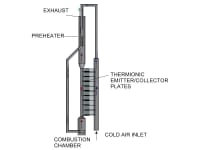Changing from a centralized to distributed power network has many advantages, including reduced transmission losses, reduced operational costs, and reduced vulnerability. Unfortunately, having a functioning power plant in every home is not particularly attractive. In order to create a distributed power network, the conversion method must be maintenance free, high efficiency, and run on a fuel source readily available across the country.
Thermionic power conversion is a technology often considered for space power generation, where there is strong emphasis on hands-free operation. The concept behind this technology relies on an emitter plate being heated to high temperatures, until the electrons of the material "boil" off the surface. They are then collected by a collector plate, and the electrons run through a circuit to get back to the emitter, thus creating electrical power. Recent advancements to thermionic technology predict conversion efficiencies of 40-50%.
These systems can be adapted to run on a natural gas source, using combustion to heat the emitter plate. Unlike traditional generators, their operation is very quiet, and require no manual operation or maintenance. Thermionic systems are also constructed of readily available materials, and do not have the large up front costs of solar panels.
The proposed idea is a thermionic power generator for residential use. Roughly the size of a water heater, these systems could run on the existing natural gas supplies of the house and provide electrical power. The increased efficiency would help to reduce pollution, and also decrease the transmission losses of the power grid. In the case of a disaster striking, every home equipped with this system would have a backup generator readily available in their home to provide electricity.
Like this entry?
-
About the Entrant
- Name:Troy Howe
- Type of entry:individual
- Patent status:none





